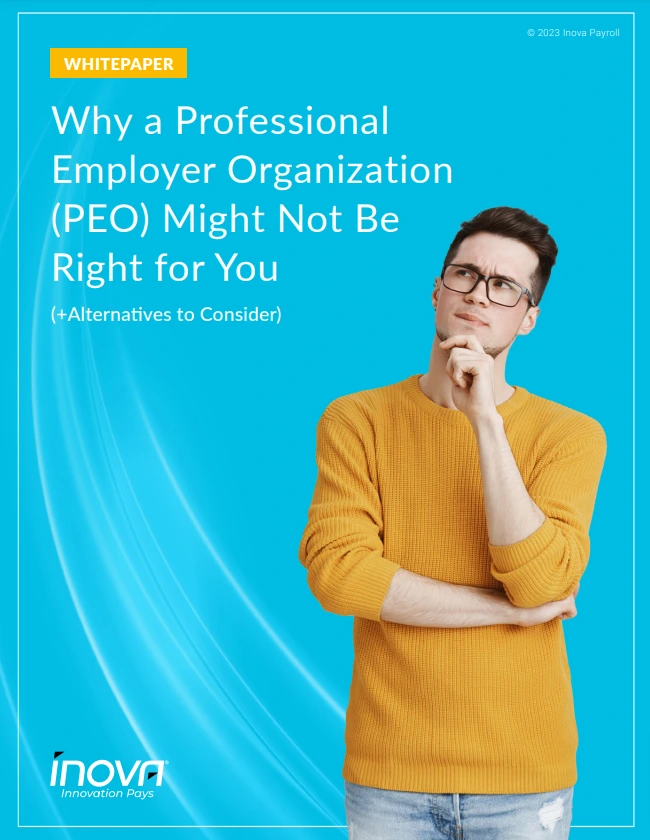No matter your role or function in a business, there never seems to be sufficient time and resources to accomplish everything you’d like to while operating at the highest possible level. But there are tools that can help.
Human resources processes require significant thought, strategy, and time, whether you have five, 50, or 5,000 employees. And in today’s climate of companies competing for limited talent, you want your human resources practices to be smooth and effective, not only for you but for your team members, as well. Fortunately, many options are available for you to get the support you need to manage your workforce.
Two options for getting HR support are PEO (Professional Employer Organization) services and HCM (Human Capital Management) software. To decide which tool is right for you, you’ll want to carefully consider your business needs, preferences, and the time your team has available to invest in the tool you select.
Shelly Mueller, Regional Sales Director with Inova Payroll, Inc., says some of the main things you’ll want to think about are:
- your budget
- your staffing
- how much you’re comfortable outsourcing
- how much control you’d like to maintain over your HR and employee processes
Mueller has more than 30 years of industry experience; she ran her own payroll and HR company in the Dallas area for 15 years before joining Inova, and she also worked for ADP for 14 years. She helps explain the pros and cons of working with PEOs and HCM software.
What is a PEO?
A PEO (Professional Employer Organization) partner functions as a co-employer, meaning that, when a company enters into a contract with a PEO, its employees become employees of the PEO. The PEO then helps your company manage HR responsibilities under its own name and employee identification number (EIN). These responsibilities can range from tax withholding to worker’s compensation claims and unemployment insurance claims, to more general human resources functions.
With some oversight from your company, a PEO can take the place of hiring internal human resources team members – handling payroll, group benefits, and other HR items. Software is typically part of the PEO offering, but the turnkey nature of PEO support is the defining quality of this option. HCM software is usually more sophisticated than the software you’ll get through a PEO partner.
PEO vs In-House
“A PEO’s sweet spot is about 100 employees or fewer. They can be good for companies small enough to have just an office manager or payroll person,” Mueller says. “It’s an analysis – the larger the company, the more expensive from a PEO standpoint. How much do you want to do yourself? How much can your internal staff handle? It comes down to how much administration you want outside your company and how much you’re willing to outsource and spend for the services.”
PEO risks are important to consider, as well, and liability is something to keep in mind here. If you work with a PEO, where does the liability fall if something isn’t handled correctly?
“People think when you’re under a PEO, you’re not liable due to the co-employer relationship. But if the PEO doesn’t file your taxes and pay the IRS with the funds you give them, for example, you are still responsible with the IRS,” Mueller says. “Likewise, when an employee has an issue, it’s still your company, just under the rules of the PEO – someone outside your organization working with your employees.
When you partner with a PEO, your unemployment tax rate is dictated by how well that PEO manages unemployment claims. You might be paying a much higher tax rate and taxes for your unemployment taxes.”
Mueller says if your company has employees who are considered high risk when it comes to benefits, you may reduce your costs by working with a PEO. She emphasizes evaluating the total costs of your options for meeting your unique needs.
What is HCM software?
HCM (Human Capital Management) software eliminates manual aspects of managing human resources, digitizing processes like recruiting, hiring, onboarding, employee growth, compliance, and payroll. The software helps you make the best use of data and process improvements to optimize your workforce. HCM software typically allows you to use only the modules you need, supporting your work while giving you more flexibility to do things your way than you’d have with a PEO.
“If you’re under the PEO, the hiring and onboarding process is controlled by the PEO and the tools they use and the benefits they have to offer,” Mueller says.
What is the difference between a PEO and HCM?
A PEO is intended to be a turnkey solution providing more than just technology. In fact, Mueller says “people don’t typically buy into a PEO for the technology,” but to more fully outsource human resources processes. HCM software requires more oversight from your internal team, but it is also more affordable, flexible, and allows for a more à la carte style of choosing the processes where you want support.
What are the Pros of a PEO?
- PEOs are designed to be a turnkey solution. While a PEO does require some oversight from you, it can be a good option for a company with no human resources employees.
- A PEO could help you take advantage of benefits that come from having a higher employee count due to the co-employer nature of the relationship – for example, better insurance rates. However, the high admin costs of the PEO may reduce the savings.
- You’ll probably have an HR consultant available to help you.
- Working with a PEO may save time spent on typical human resources follow-up tasks. For instance, if a new employee doesn’t complete their new insurance enrollment, you would normally need to check in with them, but that would instead be handled by the PEO.
What are the Pros of HCM Software?
- HCM software is often less expensive than working with a PEO.
- HCM software is usually more sophisticated, robust, and user-friendly than what you’d find working with a PEO, with mobile options that make sense in today’s digital world.
- More updated software and working with an in-house colleague may provide a better employee experience for your team members, particularly when it comes to onboarding, an especially key component of the employee experience.
Frequently Asked Questions
Does a PEO replace HR?
Engaging a PEO takes many critical human resource tasks off your list but it doesn’t completely absolve you of responsibility for HR compliance. You may be able to reduce your HR staff but should also make arrangements for oversight of the HR function within your organization.
“You have to make sure the PEO is doing everything correctly – the people are still your employees,” Mueller says. “As the company, you’re usually the tier one support, so when an employee has an issue, they’re going to come to you or your management team. The PEO is on the sidelines and may delay communication and resolution.”
One disadvantage of working with a PEO is that companies sometimes don’t see the value of all they’re getting access to and paying for. For example, you still have to review and approve your own payroll and manage your employees. For that reason, it may feel to companies like they’re not utilizing what they thought they were paying for.”
If I choose to work with a PEO or use HCM software, will I give up control over processes?
If you choose to work with a PEO partner, you may give up some control to enjoy the benefits of a more hands-off approach (but remember, you should still oversee your PEO, since any liability concerns are ultimately still yours). With HCM software, your team gets support while remaining in charge of all processes and having more control over which processes they truly need support to manage.
Will using a PEO or HCM software to support human resources shrink my team or leave my team members concerned that their jobs might be eliminated?
It depends on your goals and how you present information about the additional support to your current employees. It’s likely any outsourcing will only cover part of what your current staff does or pick up those tasks and projects that were not getting done. Often, outsourcing frees your team to focus less on transactional work and more on core business functions.
What kinds of tools do HCM software solutions provide my employees?
Whatever tools you need, for the most part. With most providers, you can customize the software so you can invest in your priorities. HCM software then runs the tools your business needs most to manage tasks like recruiting, hiring, and managing people, benefits administration, time and attendance, and much more.
What does PEO stand for in HR?
PEO stands for Professional Employer Organization and is sometimes also known as an employee leasing organization.
What does HCM stand for in HR?
HCM is Human Capital Management and often refers to a human resource software or platform that helps employers manage employee data, including recruiting, hiring, onboarding, performance evaluations, benefits enrollment, payroll and employment taxes, and more.
Carefully evaluate which type of resource will be the best fit for your needs, whether that’s a PEO, HCM software, or something in between, like outsourcing payroll under your own EIN and using a company for selective HR assistance. Using the services of an HRO (HR Outsourcing) or ASO (Administrative Services Organization) provides options for companies that are not interested in co-employment but want some of the outsourcing benefits.
Once you begin researching your servicer options, you’ll be well-positioned to evaluate them based on the price, the product, and the customer service you’re looking for.






